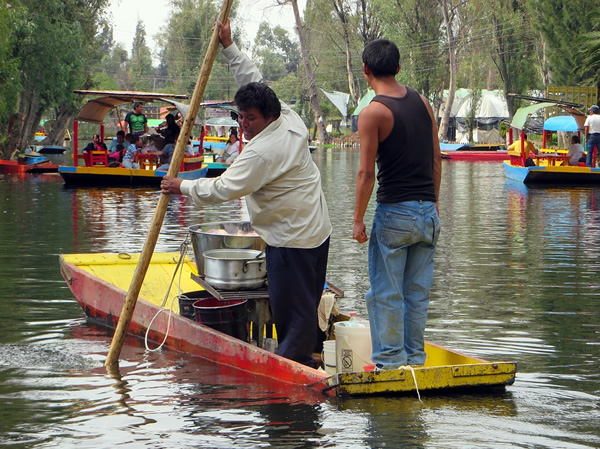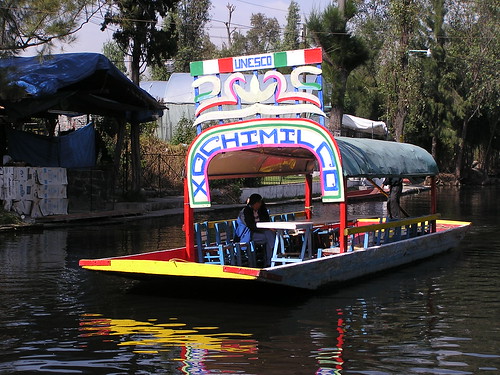The Floating Gardens of Xochimilco, Mexico
City
Tourism Maintains Local Jobs
By Ron Mader

Men rowing amid other boats full of tourists in the famous "Venice of Mexico."
The highlight of any trip to Mexico City is a visit to the canals and gardens of Xochimilco, one of the original breadbaskets of the Americas and once the agricultural hub of Tenochtitlán, a metropolis of 235,000 inhabitants. In the Aztec's Náhuatl language the name Xochimilco means "garden of flowers."
Xochimilco is divided into a traditional area and a newer ecological park north of town as part of a multi-million dollar "ecological rescue project" spearheaded by the federal government. Both areas offer excellent bird watching.
The more touristed canals are lively, particularly on weekends. Brightly-colored, squarish boats (trajineras) carry up to a dozen passengers. Families visit the park en masse and boats carrying musicians serenade young lovers. There are always plenty of vendors (in smaller canoes) with food and drink, souvenirs, and music. Hire a floating mariachi band. Three songs for about 200 pesos!
The Floating Gardens
Today, as in centuries past, canals surround raised agricultural fields called chinampas. Since the Valley of Mexico was originally wetlands, the chinampas were the most productive means of agricultural production. Chinampas are formed by alternating layers of aquatic weeds, muck, and earth packed inside rectangular cane frames firmly rooted to the lake floor. The "floating gardens" are anchored to the lake bottom by trees planted along the edges of the fields.
The Xochimilca people founded their city at the southern tip of the valley between the eighth and tenth centuries. Another tribe, the Aztecs (or Mexica), founded Tenochtitlán and the Aztec empire farther north. Soon after the Aztecs' arrival, they conquered the Xochimilcas, whose chinampas were used to provide the food for the growing Aztec empire.
In the late 1500s, before the Spanish conquest, chinampas covered nearly 22,230 acres on the lakes of Xochimilco and Chalco. Every 2.47 acres could feed about 20 people, supporting most of Tenochtitlán's residents. When the Spanish arrived they began to drain the lake bed. Today's canals are the remainders of what was a much larger system.
The once proud agricultural hub of Xochimilco became a neglected garden. Hundreds of years later, in the 1970s and 1980s, the ancient gardens became a depository for the city's waste waters. The freshwater springs that once fed Lake Xochimilco were successively diverted to provide a water supply for Mexico City.
Since most of the water that reached the canals was contaminated by residential or industrial pollution and could not be used for food crops, the chinamperos chose to increase flower cultivation instead. With discarded oil cans they hauled organic muck from the bottom of the canal. In 1990 Xochimilco was finally declared an urban ecological park, and waters are now kept clean year round.
The chinampas are not mere historical artifacts but living examples of sustainable agriculture. Farmers continue to scrape muck and organic debris from the canals, and use it as fertilizer for the agricultural gardens. They harvest chilicastle, the plentiful, shiny blue-green algae that grows on the water's surface to help maintain the soil's fertility.
The Benefits of Responsible Tourism for the Local Economy
Xochimilco was first recognized as a tourist attraction in the 1920s. European guidebooks romanticized the gardens and described Xochimilco as "the Venice of Mexico." Today the region depends on tourism to maintain jobs for thousands of workers — from musicians to cooks to craft vendors. As testament to the site's historic value, UNESCO declared Xochimilco a Cultural Heritage Site.
Your visit can assist local environmental conservation efforts. If you are taking a trip from the Navitas or Catalongo landings, ask your boatman to take you to the Apatlaco Canal, where one family has set up a breeding area for the axolotl, an endangered salamander. Contributions to support this work are encouraged. Viewing the animal is free.
Xochimilco is in the southern part of Mexico City about 23 kilometers from the historic center. Take Mexico's City Metro to the Tasqueña station and then the light train (tren ligero) to the end of the line and the Xochimilco stop. From the center of Mexico City the trip takes 60 to 90 minutes. From the Xochimilco train stop you have a few options. There are several boat landings (embarcaderos) within walking distance, or take a taxi to the Navitas landing.
 |
| Xochimilco:
A UNESCO World Heritage Site. |
Access to the canals is free. If you are traveling in a group, you can rent a blue-roofed boat (which accommodates up to a dozen people) for 150+ pesos per hour. The larger green-roofed boats run 150-200+ pesos per hour. Shorter (30-minute rides) can cost as low as 20 pesos per person. Boats rides for individuals or couples can go from 750 pesos to 3000 pesos for 2 hours. But always be wary of those trying to overcharge significantly, as with all tourist locations. Review sites describe some operators who demand 10 times the fees, so do bargain and negotiate. If you speak Spanish, it is a big plus in terms of getting a good deal.
Floating food services are located in the more touristed areas of the canals. The Navitatas market has several modest restaurants as well as an aisle of insistent meat sellers who offer samples of carnitas.
To see chinampas where farmers cultivate corn and vegetables in the summer and flowers in the winter you have to get off the beaten track. Geographer Phil Crossley has studied the chinampas for the past 15 years and suggests traveling to San Gregorio, 20 minutes east of the final stop of the tren ligero (electric train).
Phil writes: "There are several places you can walk out into chinampas being farmed in vegetables, mostly lettuce, spinach, and some other local favorites, including acelga and verdolaga. The easiest one to find and get to is right beside the El Acuario restaurant. You can walk alongside some former chinampas, cross the Canal Nacional street, formerly a canal that connected Mixquic, San Luis, and San Gregorio to Xochimilco, and then on to the Jamaica Market. Farmers are friendly and don't seem to mind visitors as long as you're careful about where you walk; greet and ask permission of everyone you meet."
After visiting Xochimilco an interesting stop is the nearby Dolores Olmedo Patiño Museum, at 5843 Avenida México. The 16th-century colonial mansion contains one of the best collections of artwork by Diego Rivera and Frida Kahlo.
South of Xochimilco is the town of Milpa Alta, which holds a fair in May and June commemorating the noble nopal (prickly pear cactus), inextricably linked to the founding of Tenochtitlán. For sale at the fair is every variety of nopal product, from the fruit to the dye produced from the cochineal worms that inhabit the cactus.
Ron
Mader is a Transitions Abroad Latin America and Responsible Travel contributor, He is host of the award-winning Planeta website.
|
